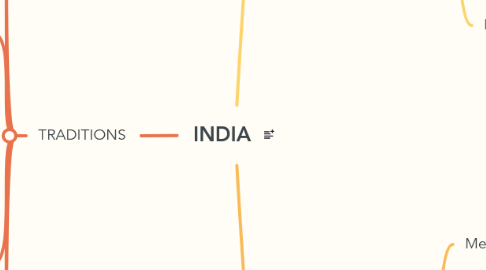
1. TRADITIONS
1.1. Makar Sakranti
1.1.1. Indians celebrate Makar Sakranti because Makar Sakranti celebrates the sun's journey back into the northern hemisphere which is considered to be a highly positive event to Indians. The festival is dedicated to the Hindu religious sun god, Surya. Makar Sakranti also represents the beginning of the harvest season when new crops are worshipped and shared with delight.
1.2. Sari
1.2.1. The word “sari” means “strip of cloth” in Sanskrit. There is a general belief that the sari is the representative of the traditional female clothing of Hindu South Asia that became diluted by the introduction from the North of tailored and stitched garments under the influence of Islam.
1.3. Mahavir Jayanti
1.3.1. Indians celebrate Mahavir Jayanti because it's to observe harmony, peace, and to spread the teachings of Mahavira, which is a supreme preacher in India. Mahavir Jayanti is one of the most important religious celebrations for Jains across the world and majorly in India. This day marks the birth of Lord Mahavir, who was the 24th and the last Tirthankara (Tirthankara is a religious leadership title) of the Jain faith, and the son of King Siddhartha and Queen Trisala.
1.4. Langota
1.4.1. Langota is a piece of clothing worn like underwear. People in India wore Langota around 3000 B.C. People believe if you wear it you are helping awaken Kundalini power, which is an ultimate life-force energy.
1.5. Gudi Padva
1.5.1. Gudi Padva commemorates the coronation of Rama in Ayodhya after his victory over Ravana. Gudi Padva signifies the arrival of spring and to the reaping of Rabi crops. Some Indians believe that the festival is linked to the mythical day on which Hindu god Brahma created time and universe
1.6. Dhoti Gamcha
1.6.1. Long loincloth traditionally worn in southern Asia by Hindu men. Wrapped around the hips and thighs with one end brought between the legs and tucked into the waistband, the dhoti resembles baggy, knee- length trousers.
1.7. Loincloth
1.7.1. Long loincloth traditionally worn in southern Asia by Hindu men. Wrapped around the hips and thighs with one end brought between the legs and tucked into the waistband, the dhoti resembles baggy, knee- length trousers.
2. ARTIFACTS
2.1. Lord of Dance, Shiva Nataraja
2.1.1. The Lord of Dance, Siva Nataraja was made from 901 AD - 1100. As a symbol, Shiva Nataraja is a brilliant invention. It combines in a single image Shiva's roles as creator, preserver, and destroyer of the universe and conveys the Indian conception of the everlasting, or never-ending cycle of time.
2.2. Rain God Pottery
2.2.1. The Rain Gods collection date from the 1880s to the late 1900s. Most Rain Gods were made between 1905 and 1910. They were marketed as traditional and sacred ceremonial "Rain Gods". In reality, They were neither traditional nor ceremonial and were produced strictly for tourist trade. Indians believe that the tesuque rain gods are an authentic expression of an indigenous art form.
2.3. The Dancing Girl
2.3.1. The Dancing Girl sculpture was made in Mohenjodaro, Sindh, Pakistan. The sculpture is made of bronze. It belongs to the Indus Valley Civilization. The Dancing Girl sculpture dates back to circa 2500 BCE. The Dancing Girl is a cultural artifact reflecting the aesthetics of a female body as conceptualized during it's historical period.
2.4. The Veiled Rebecca
2.4.1. The Veiled Rebecca was made in 1876 done by sculptor G.B. Benzoni. The Veiled Rebecca is made of marble sculpture. This sculpture is a masterpiece of the kind of naturalistic carving popular in the 1800s. Indians believe that the Veiled Rebecca represents innocence and purity. The statue represents the Old Testament figure of Rebekah as she meets her bridegroom, Isaac, the son of Abraham. Rebekah’s eyes and gesture of securing the veil at her neck signal her innocent modesty.
2.5. Noah Bells
2.5.1. 'Noah Bell' is the common name given to this distinct type of bell that possibly originated from monasteries in India hundreds of years ago. A tale said that Noah Bells divinely imbued with the power to ward off bad spirits and promote good energy in your home.
3. RITUALS
3.1. Meditation
3.1.1. Indians meditate, according to Hindu teachings, it's a tool that enables beings to quiet the disturbances of the mind so that they can tap into their innately Divine nature. Meditation is believed to improve healing ability and enhance creativity, in addition to awakening the heart and mind and allowing for inner growth.
3.2. Yoga
3.2.1. In India, the practice of yoga is based on a comprehensive philosophy of man striving for harmony with himself and the world. Still, the teachings of yoga revolve around the practice of mental discernment, detachment, spiritual knowledge, and self-awareness.
3.3. Recitation of scriptures by Bhagavad Gita
3.3.1. Reading Bhagavad Gita teaches you how to handle that knowledge. It teaches, and represents the sentence, "one can kill only the body; the soul is immortal." It means that at death, the soul is reborn in another body, or, for those who have fully grasped the true teachings, it achieves release or extinction that is, freedom from the wheel of birth. Bhagavad Gita is very important to the people of India because it's stated that the selfless actions of Bhagavad can lead people to he enlightment.
3.4. Samskaras
3.4.1. Samskaras are not considered as an end in themselves, but are means of social recognition as well as the passage of a person from one significant stage of life to another. Samskaras are to purify the soul, and mark the various stages of life.
3.5. Puja
3.5.1. Puja is to celebrate the presence of special guests, or their memories after they die. The word Puja represents reverence, honor, homage, adoration, and worship.
3.6. Sacrifices
3.6.1. In some sacred groves of India, animal sacrifice is practiced to pacify female deities that are supposed to rule the groves. Sacrifice is a celebration of life, a recognition of its divine and imperishable nature.
